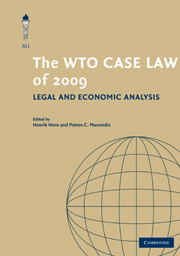Book contents
- Frontmatter
- Contents
- Foreword
- Introduction
- US Compliance with WTO Rulings on Zeroing in Anti-Dumping
- United States – Continued Existence and Application of Zeroing Methodology: the end of Zeroing?
- Incomplete Harmonization Contracts in International Economic Law: Report of the Panel, China – Measures Affecting the Protection and Enforcement of Intellectual Property Rights, WT/DS362/R, adopted 20 March 2009
- Comment
- Trading Cultures: Appellate Body Report on China–Audiovisuals
- Comment
- ‘Optimal’ Retaliation in the WTO – a commentary on the Upland Cotton Arbitration
Comment
Published online by Cambridge University Press: 05 December 2011
- Frontmatter
- Contents
- Foreword
- Introduction
- US Compliance with WTO Rulings on Zeroing in Anti-Dumping
- United States – Continued Existence and Application of Zeroing Methodology: the end of Zeroing?
- Incomplete Harmonization Contracts in International Economic Law: Report of the Panel, China – Measures Affecting the Protection and Enforcement of Intellectual Property Rights, WT/DS362/R, adopted 20 March 2009
- Comment
- Trading Cultures: Appellate Body Report on China–Audiovisuals
- Comment
- ‘Optimal’ Retaliation in the WTO – a commentary on the Upland Cotton Arbitration
Summary
I would like to add to the analyses of the authors comments on two questions: First, how should measures falling under the GATT be distinguished from those falling under the GATS? Second, could a measure inconsistent with one WTO agreement be justified by an exception contained in another?
How should measures falling under the GATT be distinguished from those falling under the GATS?
The Appellate Body concluded in China–Publications and Audiovisual Products that ‘where the content of a film is carried by physical delivery materials, [the Chinese restriction] will inevitably regulate who may import goods for the plain reason that the content of a film is expressed through, and embedded in, a physical good’. For the Appellate Body, this effect on goods (i.e., the physical film reel that crosses the border) is ‘inevitable, rather than “incidental”’ and ‘the mere fact that the import transaction involving hard-copy cinematographic films may not be the “essential feature” of the exploitation of the relevant film does not preclude the application of China's trading rights commitments to the Film Regulation’.
The authors ask whether the Appellate Body will ‘automatically find a good whenever it sees tangible material? Is, for example, a paper lottery ticket automatically a good – so that cross-border restrictions on lottery activities affect trade in goods? – or merely an element in the supply of (lottery) services, making the entire activity subject only to GATS?’
- Type
- Chapter
- Information
- The WTO Case Law of 2009Legal and Economic Analysis, pp. 119 - 132Publisher: Cambridge University PressPrint publication year: 2011



